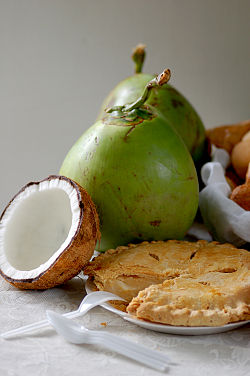Buko pie
 |
|
| Type | Pie |
|---|---|
| Place of origin |
|
| Region or state | Laguna Province, Luzon |
| Main ingredients | Pie shell, custard, young coconut, sweetened condensed milk |
| |
|
Buko pie is a traditional Filipino baked young-coconut (malauhog) custard pie. It is considered a specialty in the city of Los Baños, Laguna located on the island of Luzon.
Popular with Filipinos, it resembles a coconut cream pie, except that it is made with young coconuts (buko in Tagalog) and has neither cream in the coconut custard filling or meringue swirls on top of the baked coconut custard. Instead, the pie uses sweetened condensed milk, making it denser and healthier. The pie is made with buko meat. There are also variations of the pie, which are similar but use slightly different ingredients, such as macapuno pie, that uses a special type of coconut which differs from ordinary coconut as it is thick and sticky. The pie was originally a delicacy only available in the Philippines, but blast freezing technology has allowed buko pie-makers the ability to export. As it has become easier to transport and more accessible around the world, people are able to buy it as a pasalubong or homecoming present after having visited the Philippines. Buko pie is traditionally plain, nowadays flavorings such as pandan, vanilla, or almond essences are used. Buko pie is similar to the Dutch-Indonesian klappertaart and the South African klappertert. Klappertaart differs from the Filipino buko pie as it is a baked creamy coconut custard without the crust, and contains raisins and nuts. Klappertert is most akin to the Filipino buko pie as it also has a crust, but differs in that it also adds apricot jam and a dash of cinnamon to the coconut custard.
The idea of the buko pie is said to have originated from the province of Laguna in the Philippines. The creators of this Filipino pastry were the Pahud sisters who were locals of the city of Los Baños, Laguna. Soledad Pahud returned to her family in the Philippines after she worked as a maid in the United States. While she was working abroad, she learned to make apple pies. In the process of starting up a bakeshop business, Pahud tried to recreate the American dessert with the help of her sisters. As apples were not native to the Philippines, Pahud along with her family improvised and replaced the ingredient with "buko" or young coconuts. Using "buko" as the ingredient for the pie filling was recommended by one of the sisters named Apolonia because of the resource's abundance locally. The Pahud sisters' bakeshop business grew into what is now Orient Buko Pie Bakeshop, their own bakery specializing in buko pies. The sisters also created their own variations of the buko pie which include apple buko pie, pineapple pie, and tropical pie.
...
Wikipedia
